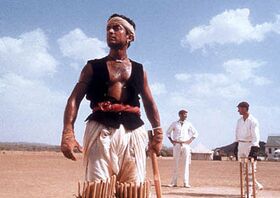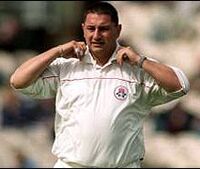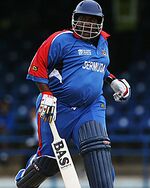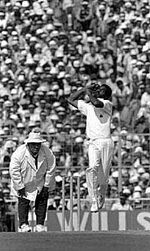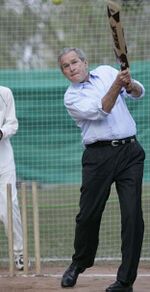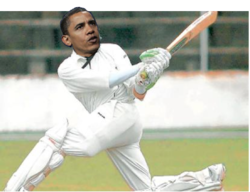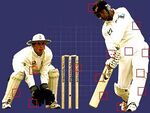Cricket
Cricket is played all over the world by eccentric idiotic police constables and others who would like to emulate them. It is also played in Australia and Yorkshire, and unlike rounders, it is not the same as baseball.
It is an apparently pointless sport with rules which no one really understands involving 15 men standing around in a field who occasionally run around, but on the whole stand completely motionless hoping something might happen. Cricket is universally considered one of the most boring and tedious of sports, but continues to be popular the world over with the boring and tedious.
Origins of cricket[edit]
People have always been hitting balls with sticks, but in its current format Cricket was first mentioned in the now lost letter of St. Paul (Third Letter to the Umpire) which questioned a decision made in a game between the Corinthians and the Ephesians. St.Paul appears to have played in that game but 'threw his bat' at an opposing player and was sent to the pavilion, located in Rome, to answer for his 'unsporting behavior'. The Romans viewed cricket a 'Jewish game' and eventually banned it in favour of more gladiatorial contests.
The game of cricket was then lost it seems until the 17th century when it seems the Dutch found an old set of rules hidden in a book in Amsterdam. The Dutch who were known for tolerating a lot of things that earnt you either a hanging or burning in the rest of Europe called the game Krookeet and liked its slow, thoughtful pace and saw it had plenty of opportunities for a gin break or a long smoke on a clay pipe whilst 'playing the game'.
It's possible 'krookeet' would have stayed a Dutch peculiarity but in what are called the 'Anglo-Dutch Tulip Wars', England and the United Provinces (the name the Dutch called their country then) took each on in a series of wars at sea. In 1667, the Dutch fleet forced their way up towards the English port of Chatham in Kent where they captured and burnt the English fleet as it was at anchor. The Dutch had discovered the English sailors were on shore playing a rough game of 3,000 a side football and had neglected to keep anyone sober on watch. To add to their humiliation, the Dutch bombarded Chatham with krookeet balls containing instructions for the game as a taunt to their neighbours across the North Sea.
The Dutch kept playing Krookeet but instead got more interested in developing their trade in exotic substances and make advances with various forms of exotic and more interesting sex. This left the field clear for the English to pretend they invented 'cricket' and everyone believed them because they had far more convincing beards.
The Englishmen gradually evolved the sport into a form known as 'Test Match Cricket'. This required five days of good weather of hitting and throwing a ball to win. At this point the game became unplayable in England, which rarely has five days without rain, and so was taken up by other nations who had better weather. Later the House of Lords realized it could be used to bore colonized peoples into abject surrender and was imported wholesale into India where, like its sister game Dysentery Faceball, it remains wildly popular.
The Australians, then developed "One Day Cricket" because no-one could be bothered playing for 5 days, and this was exported back to England who retaliated with "Twenty20 Cricket". The game of cricket is gradually evolving into a shorter game, and it is predicted that by the year 2020 a typical match of International Test "Quick Cricket" or "Tip and Run" will take about 5 minutes, leaving more time for drinking in the bar.
Evolution of cricket[edit]
Archaeologists agree that certain quirks unique to cricket indicate that the sport was played in the Middle Ages and possibly as early as the late-Triassic period. There is speculation as to how a bipedal dinosaur may have held a cricket bat, specifically:
- The side-on stance of batsmen suggests that cricket pre-dates the evolutionary processes that caused the eyes to move from the sides of the head to the front of the face;
- The straight-arm action of (most) bowlers suggests that cricket may date to a time before the development of the elbow in modern apes;
- There is no archaeological evidence for any other sport involving meals being consumed by the players during the match (with the obvious exception indoor sports such as darts and poker), and this practice may have arisen from ritualistic cannibalism where the batsman is killed and eaten after being given 'out' by the umpire.
- Cricket in not just rounders for over-grown public schoolboys, bogans, fawning colonials and fat Northerners. Honest.
Rules of cricket[edit]

The "laws" of cricket are simple, and are summarised by the International Crocheting Club (ICC) as follows:
- Each game requires 2 teams, who get to hit their balls (when they are called the 'batsmen' and not 'batters' as in Baseball, or 'batty' as in Northern Englishmen) or to bowl (not pitch or throw or chuck) their balls then chase after them ('fielding').
- One round of hitting the balls is called an innings (from the Latin "an outing, or picnic", plural innit, as in: "Why, Thompson this game rather something of a picnic, innit?").
- Some games last 5 days, and usually comprises of 2 innings (innit) or less if everyone can't be bothered to play that long, it gets dark or the spectators go home.
- Each team has 12 players each although only 11 play and the 12th man is called the "12th man" who gets the drinks. One team fields and bowls, and the other bats. Batting is the only remotely interesting part of the game, but bowling is also popular as you are allowed to try and hurt the batsman.
- When the batsman who's in is out, then he goes off and the next man comes on until he's out. The object of the game for the batsman therefore is to make sure he doesn't go out. The end of an innings is declared when 10 batsmen are out, even though there are 11 playing not counting the 12th man. So there is a batsman still in although his team is out, but he has to go off. When the batsmen are all out, the side that's out comes in and the side that's been in goes out and tries to get those coming in out.
- There are two additional fat men called umpires who stay all out all day and give the batsmen who are in out. So long as they are out. But a batsman is not out unless the fielders appeal first to the umpires by giving them various gifts, glances or sly winks and nudges. If the umpires don't like something, such as player interfering with another player behind the sight screen, then the umpires can declare that it's simply not cricket which means it's cricket but shouldn't be.
- An over is over when the bowler has 6 or sometimes 8 balls depending on how over the line he was or how far over the limit the umpire is. Many umpires count their balls in their pocket until it's over to make sure. An innings may be over after 55 overs, or 40, or 20, or sometimes a lot less if there has been a "follow-on", if you follow, or declare for that matter.
- When both sides have all been in and all the men have been out, including those who are not out (if they declared), and both sides have been out twice or maybe once or less if someone declared or it rained, then that is the end of the game.
- If the bowler hits an off-stump leg-bye then a sticky wicket is called and the game breaks for tea; however, should an elbow on-side be called, unless it's caused by a spin-twist shot or a slippy duck, then the innings may be declared over or the over under the innings. In the case of the deep-wide short-fine leg being run out by the slip's backward point boundary man, the batting team are forced to substitute their 12th man for a golden duck and a cup of Dilmah Tea.
When a man goes out to go in, the men who are out try to get him out, and when he is out he goes in and the next man in goes out and goes in. There are two men called umpires who stay all out all the time and they decide when the men who are in are out or not out. When both sides have been in and are all out, twice after all the men have been in, including those who are not out, then that's it.
Despite the apparent simplicity of these rules, there remain a number of uncivilised nations in Northern Europe and North America and North Africa who are yet to embrace the civilising effects of the game of cricket.
The toss[edit]
Before the game commences, the umpire judges whichever captain is deemed to be the biggest tosser and he gets to choose whether to bat, field, or go to the pub.
The follow-on[edit]
Basically, if often one team's batsmen are all out so the innings is ended but they haven't scored enough runs or maidens to avoid being "Toffed", then a Follow-on is declared. The batting team then forfeits their tea and scones and has to bat again without getting to bowl a maiden over. It's all frightfully upsetting, and no-one really understands this inscrutable rule, but everyone who follows Cricket pretends that they do follow it... hence the name.
Cricket to a foreigner[edit]
You have two sides, one out in the field and one in. Each man that's in the side that's in goes out, and when he's out he comes in and the next man goes in until he's out. When they are all out, the side that's out comes in and the side that's been in goes out and tries to get those coming in, out. Sometimes you get men still in and not out. When a man goes out to go in, the men who are out try to get him out, and when he is out he goes in and the next man in goes out and goes in. There are two men called umpires who stay all out all the time and they decide when the men who are in are out. When both sides have been in and all the men have been out, and both sides have been out twice after all the men have been in, including those who are not out, that is the end of the game!
Fitness and fashion[edit]
Cricket is a deceivingly demanding sport; players spend a long day on their feet at the bar, waiting to be served or to bat. However cricketers must be relatively "fit" as they may need to perform periodic fast sprints to the toilet, rubbing of balls to ensure they are kept shiny, various dynamic movements such as throwing-up, as well as leaping in the air from a prone position and turning quickly then running away from cuckolded husbands. Dodging cans of beer while fielding near the crowd also maintains awarenness and selects for a hard skull. Being overweight can be useful when receiving a fast ball in the stomach (Gut Before Wicket) although finding and disgorging the ball from the layers of flab can be tiring.
Modes of dismissal[edit]
There are many ways to get out in the game of Cricket.
Run out A batsman may be in for such an abominably tedious length of time that he runs out of enthusiasm for playing any further and leaves the field in order to find the nearest drinking establishment.
Bowled This occurs when a sadistic delivery from an ultra-fast bowler takes the hair off the batsman. The batsman needs to duck in this situation to avoid being out, so that he becomes out anyway.
LBW Although no cricket analyst has ever worked out what this stands for, the most frequent guess was that it "sounds like a band of some sort." A batsman is said to be out by "LBW" when he tries to get his Legs Between the Wickets. This was allowed in early ages when the stumps were too costly but then scrapped later as their sales dropped.
Stumped The batsman can be stumped when asked a extremely difficult question, but also can happen to older umpires who are unable to remember the score.
Caught The batsman is caught performing some socially unacceptable act, which is declared "not cricket". He must then leave the field in embarrassment. In view of this rule, The rules in cricket are so fickle in places that Ian Botham, legendary all-rounder, was caught on camera picking a bogey and swallowing it whole, and had to walk, but Phil Tufnell regularly got away with skinning up and smoking spliffs while playing in the slips.
Handled the ball Due to the very itchy nature of the fabric used in cricket underpants cricketers constantly need to rub their trousers in an attempt to relieve themselves. A player may attempt strategic rubbing of the surface of one side of the ball against their genitals through their trousers, but will be given out if they directly handle their penis.
Obstruction This occurs when a batsman attempts to interfere with a fielder. This usually involves placing an object such as a tank-trap, barbed-wire fence, brick wall or other obstruction in the way of the fielder.
Hit wicket When a batsman is unceremoniously hit in his middle stump while trying to play a stroke causing him to fall to the ground in extreme pain, he is thus forced to walk, but more usually waddle or crawl while carefully nursing his third man.
Retired out Sometimes during extremely long matches batsmen may pass the mandatory retirement age (65 in many countries) and be forced to leave the field to go and play bingo.
Not Cricket This is the most perplexing form of dismissal for "foreigners" (non-cricketing nations) to understand. If something "isn't cricket", then it is "just not on, old boy", in which case you are dismissed "and it serves you bloody-well right." A Not cricket decision is signalled by sounds of "Tut-tut" and "Harrumph" from the Members' Stand. This therefore is related to but varies from Toffing (see below). The umpire will then dismiss the player by waving his handkerchief in the direction of the player and blowing his nose loudly in it.
Six and Out This happens when the ball is hit over the fence and into the back garden of the neighbour, who then refuses to give the ball back. The batsman is given six and out, although six of what varies regionally.
Toffed A batsman of a lower class may be given out 'toffed' if there is sufficient condescending frostiness from the more wealthy spectators. This frostiness may be expressed through symbolic gestures, such as sleeping, reaching one's 80th birthday, or gazing indifferently into the rim of a straw trilby. This traditional but controversial rule has only been exercised once, in a match between Eton Old Boys' XI and Slough Urchins XI at The Oval in 1922, when the entire Slough team was given out 'toffed', basically forfeiting their entire innings. Eton went on to win by 4 runs.
Sledging This method of dismissing the batsman was first perfected by the Australian Test XI in 1952. "Sledging" a batsman involves calling nasty names or saying horrible (and untrue!) things about his mother. The batsman is judged to be 'sledged' when he breaks down in tears and is unable to carry on, at which stage the square leg umpire will bring the symbolic handkerchief (see Morris Dancing) for him to blow his nose and to go back to the pavilion for some quiet time alone.
Fielding positions[edit]
While playing Cricket, 97% of the time is spent not actually playing Cricket. Thus, officials have developed a series of "fielding positions" in order to trick players into waiting around for their go at batting. This has driven most fielders insane as they wander forward several feet every time the ball is bowled, and clapping their hands at the sky.
Batsman Not being sexist, in cricket even women who bat are called batsmen rather than batswomen. Batting is the only relatively interesting part of the game which explains the annoyance seen in the batsman when their turn is over an they are forced to go back to either standing or sitting around doing nothing.
The Runner The batsman to whom the bowler doesn't bowl. He is used when the batsman is too fat to run between the wickets himself.

Wicket Keeper This is a very important position, especially during Test Matches which may last 5 days, occasionally with a result. At the end of each day, "Stumps" is declared by the umpires, and the wicket is given to the wicket keeper to guard overnight.
Umpire There are numerous umpires. The two on-field umpires are officially hired fat old men, one of whom stands behind the bowler's wicket (the wicked umpire) and one who hides in the field. A new "third umpire" or "television camera" has recently been introduced to the game: this provides an opportunity for the other 2 billion "at-home" umpires to adjudicate.
Slips The extremely lazy may field in the slips as it requires no physical movement whatsoever, and is popular with those wishing to smoke when on the pitch. Their main responsibility is to stand close behind the batsman and try to distract him with passive smoke inhalation.
Gully Short for 'gullible player'. This is where a batsman likes to thwack the ball hardest. Fielding teams like to place their most expendable player there.
Fine leg Any fielding position where the fielder insists on wearing shorts rather than pajamas in order to show off his freshly-waxed legs.
Long Leg A fielding position reserved for the oldest player in the team. They are allowed to drink refreshments and eat sweets provided by the crowd.
Short leg This is not the disadvantage one would think. David Boon from Tasmania and Sachin Tendulkar from India had short legs on both sides and still performed remarkably well.

Silly point A fielder at silly point is generally no more than 3 yards from the batsman and will attempt to get the batsman in fits of laughter using a series of jokes and entertaining outfits until he is unable to play.
Stupid point A fielder at stupid point is generally no more than 1 foot from the batsman and will attempt to block the ball using his face.
Cover A Cover position is responsible for covering the pitch when it starts raining.
Point The Point's job is to stand and point at the ball so that other players and cameramen know where to look. During the drinks breaks it is also his responsibility to point out the slappers in the crowd.
Third man Usually a large, dim-witted player who isn't good enough to field with rest of the team, and whose main job is to shift his bulk left and right in an attempt to not embarrass the rest of his team mates too much. May also play the zither and lurk in the background where the screens are kept.
Twelfth Man The person who is most respected by for bringing out the drinks.
Doggie Nothing to do with cricket, but a fine position none the less.
Batting shots[edit]
Forward Defensive An ironically named shot, as it implies that the team's position moves forward. In fact, the batsman moves forward to block the ball into the ground, but often hits the ball straight to Silly Point. Cricket pundits Boycott and Lawry were able to bat for several months without getting out (and sometimes scoring 30) using this technique.
Backward Defensive ˙ʇǝʞɔıɹɔ ɥsıןƃuǝ oʇ uoıʇnqıɹʇuoɔ sıɥ ɹoɟ sqnןɔ ɹǝɥʇo ɯoɹɟ ʎǝuoɯ ɟo ʇunoɯɐ ǝƃɹɐן pıɐd uǝʇɟo sɐʍ ǝɥ ˙sunɹ ǝɹoɔs oʇ uɹoqqnʇs ooʇ ƃuıǝq puɐ ʇoɥs sıɥʇ ɟo ǝsn sıɥ ɥʇoq ɹoɟ snoɯɐɟuı sı ʇʇoɔʎoq ʇıpund ʇǝʞɔıɹɔ ˙ʇuıod ʎןןıs oʇ ʇɥƃıɐɹʇs ןןɐq ǝɥʇ sʇıɥ uǝʇɟo ʇnq 'punoɹƃ ǝɥʇ oʇuı ןןɐq ǝɥʇ ʞɔoןq oʇ pɹɐʍɹoɟ sǝʌoɯ uɐɯsʇɐq ǝɥʇ ˙pɹɐʍɹoɟ sǝʌoɯ uoıʇısod sɯɐǝʇ ǝɥʇ ʇɐɥʇ sǝıןdɯı ʇı sɐ 'ʇoɥs pǝɯɐu ןןʎɐɔıuoɹı uɐ
Hook Drive. The batsman dresses up like Peter Pan's enemy and tries to hit the ball with his steel claw. Risky shot but cricket fans like it.
Straight Drive The most heterosexual of cricket shots. This involves the batsman hitting the ball directly down the wicket in an attempt to either win the match by killing the bowler or drawing the match by killing the umpire.
Cover Drive Much the same, but the batsman attempts to disguise the shot with one of those spiffy white towels the bowlers use to tamper with the ball.
Sweep The batsman goes down on one knee to look into a mini-fridge. He then sweeps the contents of the fridge into his cricket box and shakes up a cocktail inside the box. The fielding side have to sip the contents of the cocktail, and whoever enjoys it the most gets a tickle down the leg side before being thrown out by a bouncer for a full toss.
Reverse Sweep As above, but with larger.
Pull The batsman reaches down to his left, (Sometimes, his right, depending on where he is playing) and tugs the handbrake to the "on" position. He then watches as the ball changes direction and returns the brake to the "off" position. This shot requires the most skill of all, as it involves very precise timing. Seventeen year-olds are particularly good at it.
Bowling terminology[edit]
Bodyline Trying to decapitate an Australian player but staying just within the rules. Later banned but Oz got their revenge.
Bouncer Fat ugly, tattoed muscleman running down the pitch to chuck a batsman off his crease. First adopted by Australia in retaliation for the above.
Chinaman Trying to bowl and eat noodles at the same time.
Googley An early version of Google, invented by Tim Berners-Lee. No advertising links.
Off Break A ball that goes so wide it ends up in the Square Leg Umpire's hat.
Maiden If a batsman was unable to score any runs off an over, the bowler was rewarded with all the available maidens in a town. Discontinued due to changing social conditions in England. Many early games of cricket were played in Maidenhead, Berkshire but that may be a coincidence.
Yorker Pitching a ball at a batsman in such a way that it breaks out into the local accent of Yorkshire. Call that a delivery? Are you from London yer soft pansy Southerner...??
Seam Bowling that "seams" good, but is in fact awful.
Equipment[edit]
Like American Football, players now need helmets and face guards, full body armour, and a well-seasoned willow bat to hit the ball and the opposition if required. All of this is new: before the 1970s cricket players only wore a padded box for their genitals and pads for their legs when batting or wicket-keeping. Otherwise they wore a soft cap and sweaty white shirt. However during the First World War, when cricket balls started to be thrown ('bowled') directly at players, head injuries increased and there was a rush to 'pad up everywhere'. Batsmen now look more like riot police than cricket players these days.
The "Duckworth-Lewis" system[edit]
An early 19th century cricket scientist Cyril Duckworth-Lewis invented this controversial rule. When there is a hurricane within a radius of 140 000 kilometers from a game of cricket any player of any team may call upon the Duckworth-Lewis system to stop all ongoing play and ensue in chasing a duck, worth the amount of exactly one Lewis. The first team to catch the duck gets 1 Lewis to do with as they please.
See also[edit]
- Michael Holding
- Cricket terminology
- Cricket commentary
- Wisden Cricketers' Almanac
- TMS
- Ashes
- Border Gavaskar Trophy
- Causes of Death of English Test Match Captains
- Allahakbarries
- Mark Robinson
- Australian Cricket team
- Age of Umpires


